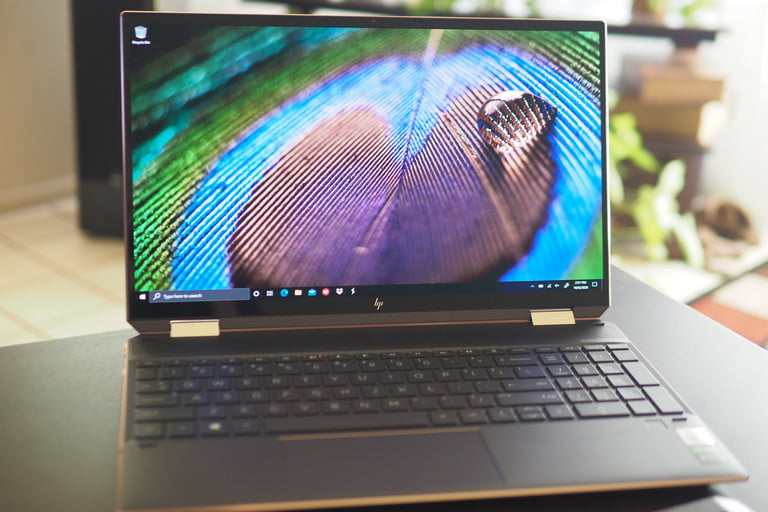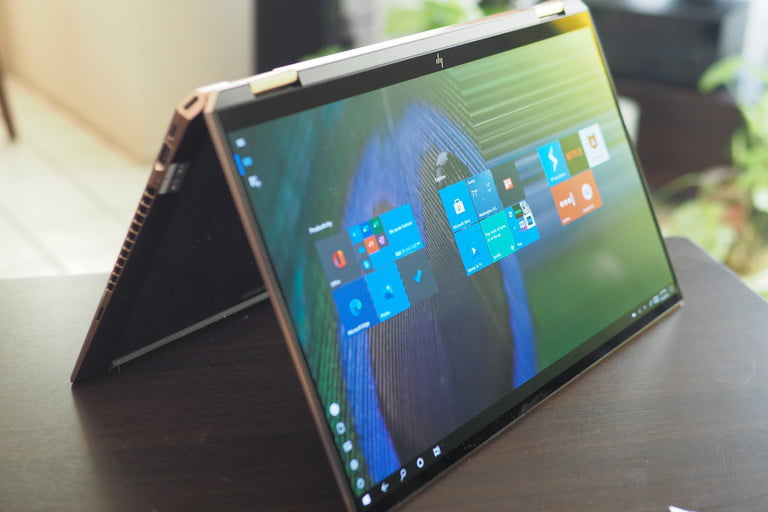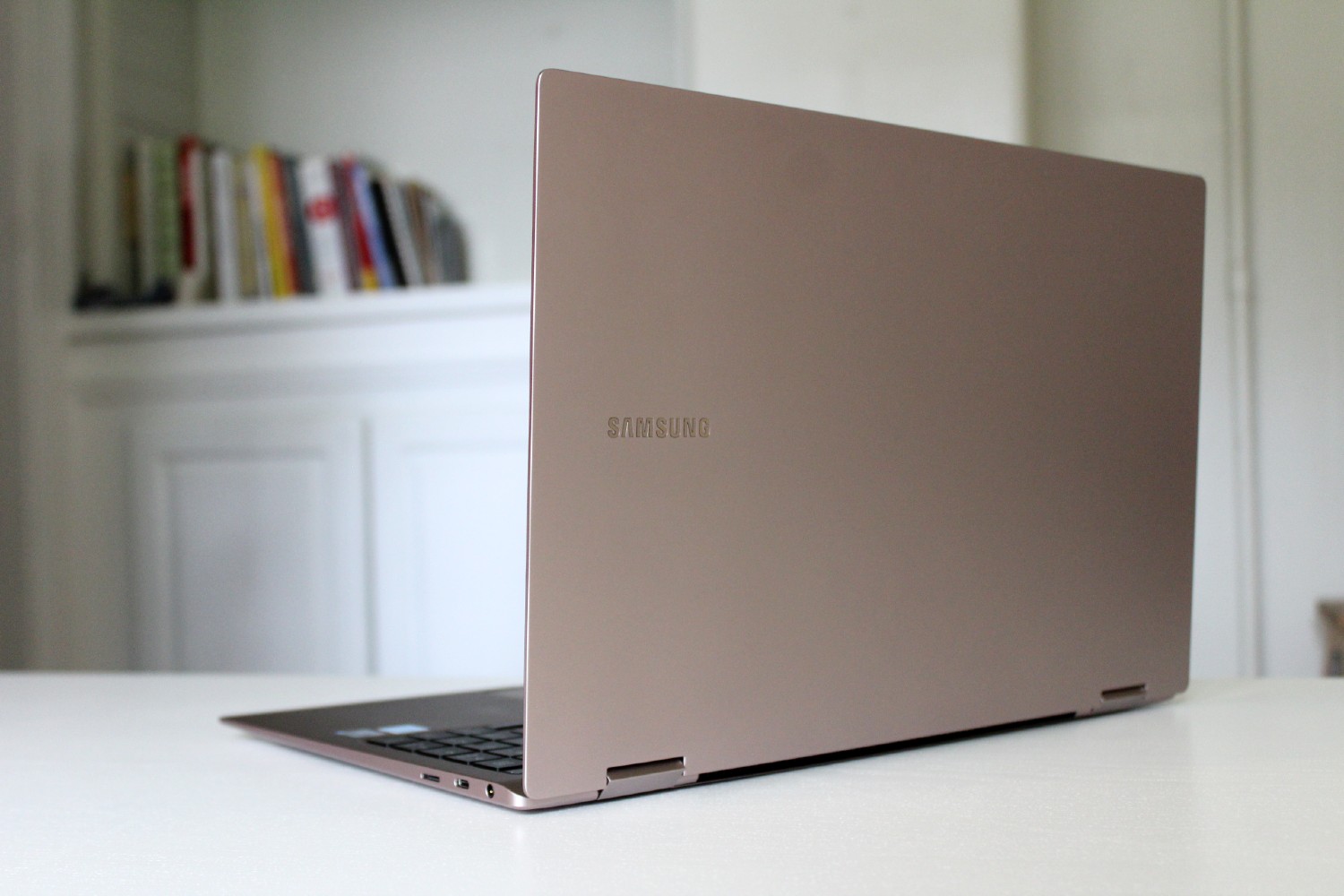Samsung recently introduced the Galaxy Book Pro 360, a convertible 2-in-1 representing its most serious effort to produce a competitive Windows 10 laptop. HP has been a leading player in that market for years, and it’s perfected the convertible 2-in-1 with strong efforts like the late 2020 Spectre x360 15. HP’s strength is illustrated by its having machines on our best 2-in-1s and best laptops lists.
Can Samsung’s upstart entry take on such an established player?
Specs

| Samsung Galaxy Book Pro 360 | HP Spectre x360 15 | |
| Dimensions | 13.97 inches x 8.98 inches x 0.47 inches | 14.17 inches x 8.91 inches by 0.79 inches |
| Weight | 3.06 pounds | 4.23 pounds |
| Processor | 11th-gen Intel Core i7-1165G7 | 11th-gen Intel Core i7-1165G7 or 10th-gen Intel Core i7-10750H |
| RAM | 8GB or 16GB RAM | 16GB RAM |
| Display | 15.5-inch OLED display | 15.6-inch OLED display or 15.6-inch IPS display |
| Resolution | Full HD (1,920 x 1080) | 4K UHD (3,840 x 2,160) |
| Storage | Up to 2TB SSD | Up to 1TB SSD |
| Touch | 10-point touch display | 10-point touch optional |
| Ports | 1x USB-C with Thunderbolt 4, 2x USB-C, micro SD card slot, 3.5mm headset | 1x or 2x USB C with Thunderbolt 3 or 4, 1x USB-C on some models, 1 USB-A, 1 HDMI 2.0, micro SD card slot, 3.5mm headset |
| Wireless | Wi-Fi 6 and Bluetooth 5.1 | Wi-Fi 6 and Bluetooth 5.1 |
| Webcam | 720p HD | 720p HD with infrared camera for Windows Hello support |
| Operating System | Windows 10 Home or Pro | Windows 10 Home or Pro |
| Battery | 68 watt-hours | 83 watt-hours |
| Price | $1,300+ | $1,400+ |
| Review | 3.5 out of 5 stars | 4 out of 5 stars |
Design

Both the Samsung Galaxy Pro Book 360 and HP Spectre x360 15 are large convertible 2-in-1s, meaning their displays flip all the way around to morph into four different formats — clamshell, tent, media, and tablet. Both make for large tablets, but the Samsung is significantly thinner than the HP, at 0.47 inches versus 0.79 inches. It’s also quite a bit lighter at 3.02 pounds versus 4.23 pounds. You’ll notice the difference if you flip into tablet mode and use Samsung’s S-Pen or HP’s active pen for Windows 10 inking.
There’s a reason why the Galaxy Pro Book 360 is so much lighter beyond its being thinner. It’s constructed of a mix of aluminum alloy and plastic, with the bottom panel notably being plastic. The Spectre x360 15 is constructed entirely of machined aluminum, and as such, it’s more rigid and feels more durable than the Samsung. The HP has absolutely no twisting, bending, or flexing anywhere on the machine, while the Galaxy Book Pro 360 demonstrated some keyboard flex, some bending in the lid, and some creaking along the sides. The Samsung doesn’t feel cheap, but it’s not as solid as the HP.
Aesthetically, the Spectre x360 15 is by far the more extravagant design, with gem-cut edges and chiseled corners that give it an elegant and very different look. It’s available in two colors, Poseidon Blue and Ash Silver (which looks more brownish in real life). The Galaxy Book Pro 360 is a more conservatively designed laptop by comparison and has nice lines and a quality aesthetic. You can choose from Mystic Bronze or Mystic Navy color schemes. If you want your laptop to stand out, then the HP is your choice, but if you don’t want to draw attention to yourself, the Samsung makes for a better offering.
For touch typists, both laptops deliver. The Samsung’s keyboard has less travel than the HP, at 1mm versus 1.5mm, but both offer scissor switches with a springy feel and comfortable bottoming action. The Spectre line has always had excellent keyboards, and the Spectre x360 15 probably wins out here thanks to the greater travel that provides more feedback during quick typing, but both keyboards are excellent. The Galaxy Book Pro 360 offers a better touchpad, though, thanks to its significantly larger size compared to the Spectre x360 15’s smaller wide version. Both support Microsoft’s Precision touchpad protocol and so both are precise and responsive, but the Samsung wins out thanks to its greater real estate.
The Spectre x360 15 has more diverse connectivity, with two USB-C ports. Models with 11th-gen Intel U-series CPUs support Thunderbolt 4 on both USB-C ports, while those with 10th-gen H-series CPUs support Thunderbolt 3 on just one port. There’s also a USB-A port, a full-size HDMI 2.0 port, a micro SD card reader, and a 3.5mm audio jack. The Galaxy Pro Book 360 offers three USB-C ports, two of which support
Performance

As alluded to above, you can configure the Spectre x360 15 with either an 11th-gen Intel Core i7-1165G7 or a 10th-gen Intel Core i7-10750H. The Galaxy Book Pro 360, on the other hand, is available with only a Core i7-1165G7. We tested the H-series version of the HP and found it to provide good creativity performance for a 2-in-1 to go with outstanding productivity performance. The Samsung was plenty fast at productivity tasks while being unable to keep up with the HP in CPU-intensive creative apps. We didn’t test the HP using some of our more recent benchmarks, such as Cinebench R23, but there’s no doubt that if you need more power in your 2-in-1, the Spectre x360 15 is going to meet your needs better.
The same holds true in GPU options. The Galaxy Book Pro 360 is available with just integrated Intel Iris Xe graphics. That’s fine for productivity work and playing games at low resolutions and settings, but it’s not a gaming laptop by any means, and the GPU won’t help out in creative apps like Adobe Premiere Pro that can make use of faster graphics. The Spectre x360 15 is available with several GPU options, including Intel Iris Xe and the low-end Nvidia GeForce MX330 discrete GPU on U-series configurations and the much faster Nvidia GeForce GTX 1650 Ti on the H-series. The latter, in particular, works well with creative apps and can do some light gaming in a pinch, making the Spectre x360 15 the more powerful graphics machine.
Both 2-in-1s are fine for productivity and media consumption, and the 2-in-1 format is great for both. The HP, though, offers a lot more power and can replace many 15-inch clamshell machines.
Display

Once again, HP offers more options than Samsung. The Spectre x360 15 can be purchased with either a 4K (3,840 x 2,160) IPS display or a 4K OLED panel. We reviewed the latter, and it’s spectacular, with excellent brightness, wide and accurate colors, and the usual OLED inky blacks thanks to unparalleled contrast. The Samsung Galaxy Book Pro 360 is available with just one display, a Full HD (1,920 x 1,080) OLED display that’s also bright, colorful, and offers great contrast. Black text pops on both displays, and both will work for creative pros who demand a lot of accurate colors.
Both 2-in-1s are great for consuming media, especially video, as long as it’s just Full HD. But the Spectre X360 15 displays are much sharper thanks to their 4K resolution, and the OLED version is particularly great for binging Netflix. Full HD might be OK on smaller displays, but Samsung did the Galaxy Book Pro 360 a disservice by limiting the resolution on the largest model.
Portability

Neither laptop is particularly easy to carry around thanks to its larger chassis. There’s no doubt, though, that the Galaxy Book Pro 360 is easier to carry than the Spectre x360 15, given its thin frame and lower weight.
We tested the H-series version of the HP, which is certainly not going to achieve the same battery life as the U-series CPU in the Samsung. Add in the Spectre x360 15’s 4K display, and it’s easy to see why the Galaxy Book Pro 360 achieved significantly longer battery life. Again, we didn’t perform all the same battery benchmarks on the Spectre, but in our web browsing and video tests, the Galaxy Book Pro lasted twice as long as the HP. Specifically, the Spectre x360 15 managed just six hours browsing the web and just under eight hours playing our test video. The Samsung, on the other hand, made it to 13 hours and 17.5 hours, respectively.
Clearly, the Galaxy Book Pro 360 is the machine to pick if long battery life is your objective. That is, if you can live with the lower resolution.
The Spectre x360 15’s pure power gives it the win
The Samsung Galaxy Book Pro 360 starts at $1,300 for the Core i7, 16GB RAM, 512GB SSD, and Full HD OLED display. You can spend as much as $1,500 for a 1TB SSD, meaning the Samsung is a premium laptop for sure.
The HP Spectre x360 15 starts at around $1,400 for a Core i7-1165G7, 16GB of RAM, a 512GB SSD, the 4K OLED display, and Intel Iris Xe graphics. It goes as high as $1,850 for the Core i7-10750H, 16GB of
We’re giving the win to the Spectre x360 15. It’s more solidly built, looks better, offers higher resolution display options, and can be configured with significantly more powerful components. That makes it the more well-rounded 15-inch convertible 2-in-1.
Editors' Recommendations
- Why one of my favorite laptops still struggles against the MacBook Pro
- HP’s new Envy x360 14 looks like a killer value for what you get
- Samsung Galaxy Book 3 Ultra vs. MacBook Pro 16-inch
- HP Dragonfly Pro vs. Apple MacBook Pro 14: a solid alternative?
- Asus ZenBook S 13 Flip vs. HP Envy x360 13: it comes down to price


